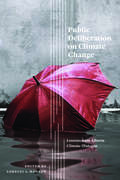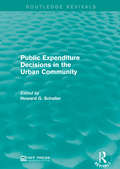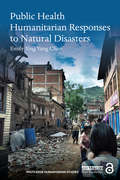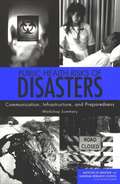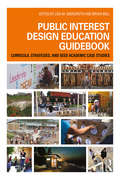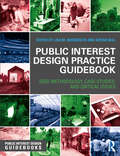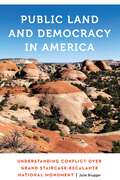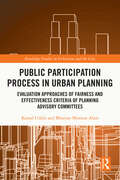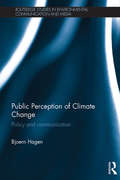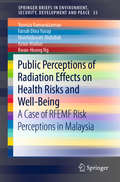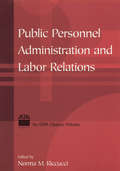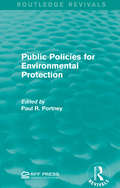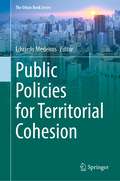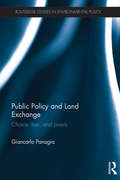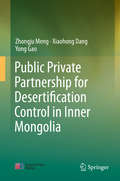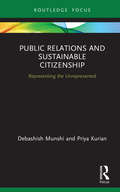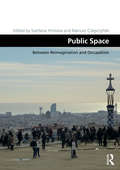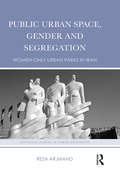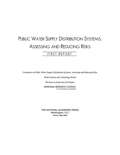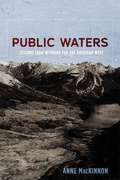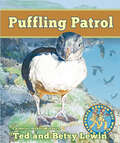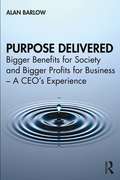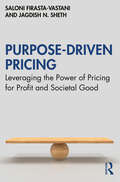- Table View
- List View
Public Deliberation on Climate Change: Lessons from Alberta Climate Dialogue
by Lorelei L. Hanson David KahaneThere exists in both academic and political circles a growing interest in public deliberation as an alternative to the sometimes adversarial and polarizing public engagement activities that result in the pitting of experts against lay people. Proponents of public deliberation claim that a more deliberative process can engage a diversity of participants in a more guided process that better balances expert knowledge and citizen inclusion. Such an approach holds particular promise where citizens and governments engage in discussions of the most complex and intractable issues like climate change. Given the host of challenges climate governance presents and the global consequences of our response to them, the experience and knowledge shared by Hanson and the contributors to Public Deliberation on Climate Change provide an important framework for advancing public conversations and processes on this and other wicked problems. The lessons contained in the volume were gained as a result of a five year multidisciplinary, community, university research project called Alberta Climate Dialogue (ABCD), which drew together scholars, practitioners, citizens, civil society members, and government officials from across Alberta at four public deliberations. By highlighting the value tensions and trade-offs and examining the impact that the design of the deliberations has on policy and the creation of conditions that encourage exchange, the contributors aim to build capacity within our institutions and society to find new ways to discuss and solve complex problems.
Public Expenditure Decisions in the Urban Community (Routledge Revivals)
by Howard G. SchallerIn 1962, the Committee on Urban Economics held a conference on public expenditure decisions in order to promote analysis of the issues facing the public sector of the urban economy. Originally published in 1965, this report pulls together key papers presented at this conference discussing issues such as urban services, the patterns of public expenditure and the quality of government services in urban areas to draw conclusions on the difficulties of analysis and how economic tools could be utilised more effectively to solve these difficulties. This title will be of interest to students of environmental studies and economics.
Public Health Humanitarian Responses to Natural Disasters (Routledge Humanitarian Studies)
by Emily Ying ChanThe pressure of climate change, environmental degradation, and urbanisation, as well as the widening of socio- economic disparities have rendered the global population increasingly vulnerable to the impact of natural disasters. With a primary focus on medical and public health humanitarian response to disasters, Public Health Humanitarian Responses to Natural Disasters provides a timely critical analysis of public health responses to natural disasters. Using a number of case studies and examples of innovative disaster response measures developed by international agencies and stakeholders, this book illustrates how theoretical understanding of public health issues can be practically applied in the context of humanitarian relief response. Starting with an introduction to public health principles within the context of medical and public health disaster and humanitarian response, the book goes on to explore key trends, threats and challenges in contemporary disaster medical response. This book provides a comprehensive overview of an emergent discipline and offers a unique multidisciplinary perspective across a range of relevant topics including the concepts of disaster preparedness and resilience, and key challenges in human health needs for the twenty-first century. This book will be of interest to students of public health, disaster and emergency medicine and development studies, as well as to development and medical practitioners working within NGOs, development agencies, health authorities and public administration.
Public Health Risks of Disasters: Communication, Infrastructure, and Preparedness
by William H. Hooke Paul G. RogersA report on Public Health Risks of Disasters
Public Health and Disasters: Health Emergency and Disaster Risk Management in Asia (Disaster Risk Reduction)
by Rajib Shaw Emily Ying Yang ChanThis book presents the health emergency and disaster risk management (H-EDRM) research landscape, with examples from Asia. In recent years, the intersection of health and disaster risk reduction (DRR) has emerged as an important interdisciplinary field. In several landmark UN agreements adopted in 2015–2016, including the Sendai Framework for Disaster Risk Reduction 2015–2030, the 2030 Sustainable Development Goals (SDGs), the Paris climate agreement, and the New Urban Agenda (Habitat III), health is acknowledged as an inevitable outcome and a natural goal of disaster risk reduction, and the cross-over of the two fields is essential for the successful implementation of the Sendai Framework. H-EDRM has emerged as an umbrella field that encompasses emergency and disaster medicine, DRR, humanitarian response, community health resilience, and health system resilience. However, this fragmented, nascent field has yet to be developed into a coherent discipline. Key challenges include redundant research, lack of a strategic research agenda, limited development of multisectoral and interdisciplinary approaches, deficiencies in the science–policy–practice nexus, absence of standardized terminology, and insufficient coordination among stakeholders. This book provides a timely and invaluable resource for undergraduate and postgraduate students, researchers, scholars, and frontline practitioners as well as policymakers from across the component domains of H-EDRM.
Public Interest Design Education Guidebook: Curricula, Strategies, and SEED Academic Case Studies (Public Interest Design Guidebooks)
by Lisa M. Abendroth Bryan BellPublic Interest Design Education Guidebook: Curricula, Strategies, and SEED Academic Case Studies presents the pedagogical framework and collective curriculum necessary to teach public interest designers. The second book in Routledge’s Public Interest Design Guidebook series, the editors and contributors feature a range of learning competencies supported by distinct teaching strategies where educational and community-originated goals unite. Written in a guidebook format that includes projects from across design disciplines, this book describes the learning deemed most critical to pursuing an inclusive, informed design practice that meets the diverse needs of both students and community partners. Featured chapter themes include Fundamental Skills, Intercultural Competencies, Engaging the Field Experience, Inclusive Iteration, and Evaluating Student Learning. The book consists of practice-based and applied learning constructs that bridge community-based research with engaged learning and design practice. SEED (Social Economic Environmental Design) academic case studies introduce teaching strategies that reinforce project-specific learning objectives where solving social, economic, and environmental issues unites the efforts of communities, student designers, and educators. This comprehensive publication also contains indices devoted to learning objectives cross-referenced from within the book as well as considerations for educational program development in public interest design. Whether you are a student of design, an educator, or a designer, the breadth of projects and teaching strategies provided here will empower you to excel in your pursuit of public interest design.
Public Interest Design Practice Guidebook: SEED Methodology, Case Studies, and Critical Issues (Public Interest Design Guidebooks #1)
by Lisa M. Abendroth and Bryan BellPublic Interest Design Practice Guidebook: Seed Methodology, Case Studies, and Critical Issues is the first book to demonstrate that public interest design has emerged as a distinct profession. It provides clear professional standards of practice following SEED (Social Economic Environmental Design) methodology, the first step-by-step process supporting public interest designers. The book features an Issues Index composed of ninety critical social, economic, and environmental issues, illustrated with thirty case study projects representing eighteen countries and four continents, all cross-referenced, to show you how every human issue is a design issue. Contributions from Thomas Fisher, Heather Fleming and David Kaisel, Michael Cohen, Michael P. Murphy Jr. and Alan Ricks, and over twenty others cover topics such as professional responsibility, public interest design business development, design evaluation, and capacity building through scaling, along with many more. Themes including public participation, issue-based design, and assessment are referenced throughout the book and provide benchmarks toward an informed practice. This comprehensive manual also contains a glossary, an appendix of engagement methods, a case study locator atlas, and a reading list. Whether you are working in the field of architecture, urban planning, industrial design, landscape architecture, or communication design, this book empowers you to create community-centered environments, products, and systems.
Public Land and Democracy in America: Understanding Conflict over Grand Staircase-Escalante National Monument (Anthropology of Contemporary North America)
by Julie BruggerIn recent years the Grand Staircase-Escalante National Monument in southern Utah has figured prominently in the long and ongoing struggle over the meaning and value of America&’s public lands. In 1996 President Bill Clinton used the Antiquities Act to create the monument, with the goal of protecting scientific and historical resources. His action incensed Utah elected officials and local residents who were neither informed nor consulted beforehand, and opposition to the monument has continued to make its day-to-day management problematic. In 2017 President Donald Trump reduced the monument&’s size, an action immediately challenged by multiple lawsuits; subsequently, President Joe Biden restored the monument in 2021. In Public Land and Democracy in America Julie Brugger brings into focus the perspectives of a variety of groups affected by conflict over the monument, including residents of adjacent communities, ranchers, federal land management agency employees, and environmentalists. In the process of following management disputes at the monument over the years, Brugger considers how conceptions of democracy have shaped and been shaped by the regional landscape and by these disputes. Through this ethnographic evidence, Brugger proposes a concept of democracy that encompasses disparate meanings and experiences, embraces conflict, and suggests a crucial role for public lands in transforming antagonism into agonism.
Public Participation Process in Urban Planning: Evaluation Approaches of Fairness and Effectiveness Criteria of Planning Advisory Committees (Routledge Studies in Urbanism and the City)
by Kamal Uddin Bhuiyan Monwar AlamThis book critically examines the public participation processes in urban planning and development by evaluating the operations of Planning Advisory Committees (PACs) through two meta-criteria of fairness and effectiveness. Traditional models of public participation in planning have long been criticized for separating planners from the public. This book proposes a novel conceptual model to address the gaps in existing practices in order to encourage greater public involvement in planning decisions and policymaking. It assesses the application of the evaluative framework for PACs as a new approach to public participation evaluation in urban planning. With a case study focused on the PACs in Inner City area of Canberra, Australia, the book offers a conceptual framework for evaluating fairness and effectiveness of the public participation processes that can also be extended to other countries such as the United States, the United Kingdom, New Zealand, Canada, Scandinavian countries, the European Union, and some Asian countries such as India. Offering valuable insights on how operational processes of PACs can be re-configured, this book will be a useful guide for students and academics of planning and public policy analysis, as well as the planning professionals in both developed and developing countries.
Public Perception of Climate Change: Policy and Communication (Routledge Studies in Environmental Communication and Media)
by Bjoern HagenDespite the findings on global climate change presented by the scientific community, there remains a significant gap between its recommendations and the actions of the public and policy makers. So far scientists and the media have failed to successfully communicate the urgency of the climate change situation in such a way that long-term, comprehensive, and legally binding policy commitments are being made on the national and international level. This book examines the way the public processes information, how they perceive threats and other perceptual factors that have a significant effect on how and to what degree climate change mitigation and adaptation strategies are supported. Understanding public risk perception plays a vital role in communicating the challenges of global climate change. Using a diverse range of international case studies, this book explores the nature of public perceptions of climate change and identifies the perception factors which have a significant impact on the public’s willingness to support global climate change policies or commit to behavioral changes to reduce greenhouse gas emissions and improve urban resiliency. The comparative study of social and cultural factors, beliefs, attitudes and trust provides an international overview of best practices regarding the design, implementation and generation of public support for climate change policies at a global level. Offering valuable insight into climate change and risk communication, the book should be of interest to students and scholars of environment studies, politics, urban planning, and media and cultural studies.
Public Perceptions of Radiation Effects on Health Risks and Well-Being: A Case of RFEMF Risk Perceptions in Malaysia (SpringerBriefs in Environment, Security, Development and Peace #33)
by Kwan-Hoong Ng Yusniza Kamarulzaman Farrah Dina Yusop Noorhidawati Abdullah Azian MadunThis book reports on the investigation of the public’s perception of Radio Frequency Electromagnetic Field (RF-EMF) radiation effects on health and well-being, in Malaysia. It elaborates on how understanding the impact of perceived risk is essential in order to investigate the explanatory value and effectiveness of interventions influencing these beliefs. The book expands on the knowledge and understanding of different risk perception related to radiation in order to explain the gap in literature regarding the relationship between risk perceptions that lead to public behaviors. In doing so, the book presents empirical findings of a national study that unveils two key factors affecting public risk perceptions: psycho-graphic and personal factors. It offers a more collective and cultural understanding of public perceptions on radiation risks via a systematic mixed-method research approach. Research in the book also show that while the radiation risk is recognizable and unavoidable, the relevant stakeholders should be more proactive and committed to communicate and rectify the perception of radiation. The book thus serves as a valuable source of reference to understand the debate and to invite more participatory dialogues on radiation risk perceptions among public.
Public Personnel Administration and Labor Relations
by Norma M RiccucciThe readings in this volume will enlighten and enliven the contents of any standard public administration text covering human resource management. Selected mainly from the pages of Public Administration Review and Review of Public Personnel Administration, these classic articles trace the historical and evolutionary development of the fields of public personnel administration and labor relations from the point at which the first civil service law was passed - the Pendelton Act in 1883 - through the 21st century. The collection covers everything from the seminal concerns of civil service (e.g., keeping spoils out) to topics that early reformers would never have envisioned (e.g., affirmative action and drug testing). These works continue to inform the theory and practice of public personnel and labor relations. To facilitate an instructor's ability to assign readings that illuminate lectures and course material, a correlation matrix on the M.E. Sharpe website shows how this book can be used easily alongside eight leading textbooks.
Public Policies for Environmental Protection (Routledge Revivals)
by Paul R. PortneyOriginally published in 1990, this study tracks the issues, progress and problems in environmental issues in the United States from the 1980’s. Improvements in air and water quality as well as regulation of hazardous waste and toxic substances has led to new policies such as the Superfund Act and a general increase in awareness about environmental issues on a federal level. Placing an emphasis on economics, these papers analyse the effectiveness of environmental policy and progress made in relation to air pollution, water quality, hazardous wastes, toxic substances and enforcement of regulations. This title will be of interest to students of environmental studies.
Public Policies for Territorial Cohesion (The Urban Book Series)
by Eduardo MedeirosThis book introduces a comprehensive and updated analysis of the role of public policies to promote territorial cohesion processes and trends in a given territory. By being the first book taking a reflective and holistic approach on how public policies can lead to more cohesive and balanced territories, it advances theoretical avenues for academics and showcases current academic research to policymakers and practitioners by focusing on how public policies, being implemented in different territorial scales (urban, local, regional, national, and European), can actively contribute to foster territorial cohesion trends in a given territory. This reflective approach provides an opportunity for thinking about what lessons can be learned from past and ongoing experiences and how they can improve future implementation of public policies more effectively and efficiently toward territorial cohesion, since all existing analyses show that at the national level, no European country has achieved territorial cohesion trends over the past decades. As such, this book acts as a valid and useful policy manual that effectively contributes to inverting current territorial exclusion trends at the national level, by highlighting best policy practices and a comprehensive introduction to contemporary thinking about how public policies can play a decisive role in boosting territorial cohesion processes in a given territory.
Public Policy and Land Exchange: Choice, law, and praxis (Routledge Studies in Environmental Policy)
by Giancarlo PanagiaThis original contribution to the field is the first to bring economic sociology theory to the study of federal land exchanges. By blending public choice theory with engaging case studies that contextualize the tactics used by land developers, this book uses economic sociology to help challenge the under-valuation of federal lands in political decisions. The empirically-based, scholarly analysis of federal-private land swaps exposes serious institutional dysfunctions, which sometimes amount to outright corruption. By evaluating investigative reports of each federal agency case study, the book illustrates the institutional nature of the actors in land swaps and, in particular, the history of U.S. agencies’ promotion of private interests in land exchanges. Using public choice theory to make sense of the privatization of public lands, the book looks in close detail at the federal policies of the Bureau of Land Management and the U.S. Forest Service land swaps in America. These pertinent case studies illustrate the trends to transfer federal lands notwithstanding their flawed value appraisals or interpretation of public interest; thus, violating both the principles of equality in value and observance of specific public policy. The book should be of interest to students and scholars of public land and natural resource management, as well as political science, public policy and land law.
Public Private Partnership for Desertification Control in Inner Mongolia
by Yong Gao Zhongju Meng Xiaohong DangIn terms of China’s current situation, the prevention and control of land degradation and the development of innovative sustainable land management activities lie within the purview of public works. Further, public-private partnerships (PPPs) hold considerable potential for application in this field. Inner Mongolia is one of the Chinese provinces hardest hit by land degradation. Fortunately, after years of dedicated efforts, meaningful achievements have been made: the increasing participation of the people as a whole, combined with growing investments in land degradation prevention and ecological construction on the part of private enterprises, has to some extent compensated for the lack of government involvement. Further, Inner Mongolia has been a pioneer in the use of PPPs for the prevention and control of land degradation, which has yielded numerous ecological, social and economic benefits. To better promote the development of ecological construction and expand the participation in land degradation control, this book systematically studies the use of PPPs in the Inner Mongolia autonomous region, drawing on field investigations and case analyses to do so. Its main goal is to explore a public-private partnership model that can effectively expand the scale of investment in land degradation prevention and sustainable land management.
Public Relations and Sustainable Citizenship: Representing the Unrepresented (Routledge Insights in Public Relations Research)
by Debashish Munshi Priya KurianThis book examines how public relations might re-imagine itself as an instrument of "sustainable citizenship" by exploring alternative models of representing and building relationships with and among marginalised publics that disrupt the standard discourses of public relations. It argues that public relations needs to situate itself in the larger context of citizenship, the values and ethics that inform it and the attitudes and behaviours that characterize it. Interlacing critical public relations with a theoretical fabric woven with strands of postcolonial histories, indigenous studies, feminist studies, and political theory, the book brings out the often-unseen processes of relationship building that nurtures solidarity among historically marginalized publics. The book is illustrated with global cases of public relations as sustainable citizenship in action across three core elements of the earth – air, water, and land. In each of the cases, readers can see how resistance movements, not necessarily aligned with any specific organization or interest group, are seeking to change the status quo of a world increasingly defined by exploitation, overconsumption, sectarianism, and faux nationalism. This challenging book will be of interest to students and scholars of not only public relations but also the broader social and management sciences who are interested in issues of environmental and social justice.
Public Space: Between Reimagination and Occupation (Design and the Built Environment)
by Svetlana Hristova Mariusz CzepczyńskiPublic Space: Between Reimagination and Occupation examines contemporary public space as a result of intense social production reflecting contradictory trends: the long-lasting effects of the global crisis, manifested in supranational trade-offs between political influence, state power and private ownership; and the appearance of global counter-actors, enabled by the expansion of digital communication and networking technologies and rooted into new participatory cultures, easily growing into mobile cultures of protest. The highlighted cases from Europe, Asia, Africa and North America reveal the roots of the pre-crisis processes of redistribution of capital and power as an aspect of the transition from the consumerist past into the post-consumerist present, by tracing the slow growth of social discontent that has led only a few years later to the mobilization of a new kind of self-conscious globally-acting class. This edited volume brings together a broad range of interdisciplinary discussions and approaches, providing sociologists, cultural geographers, and urban planning academics and students with an opportunity to explore the various social, cultural, economic and political factors leading to reappropriation and reimagination of the urban commons in the cities within which we live.
Public Urban Space, Gender and Segregation: Women-only urban parks in Iran (Routledge Studies in Human Geography)
by Reza ArjmandPublic spaces are the renditions of the power symmetry within the social setting it resides in, and is both controlling and confining of power. In an ideologically-laden context, urban design encompasses values and meanings and is utilized as a means to construct the identity and perpetuate visible and invisible boundaries. Hence, gendered spatial dichotomy based on a biological division of sexes is often employed systematically to evade the transgression of women into the public spaces. The production of modern urban space in the Middle East is formed in the interplay between modernity, tradition and religion. Examining women in public spaces and patterns of interaction with gender -segregated and -mixed space, this book argues that gendered spaces are far from a static physical spatial division and produce a complex and dynamic dichotomy of men/public and women/private. Taking the example of Iran, normative and ideologically-laden gender segregated public spaces have been used as a tool for the Islamization of everyday life. The most recent government effort includes women-only parks, purportedly designed and administered through women’s contributions, as well as to accommodate their needs and provide space for social interaction and activities. Combining research approaches from urban planning and social sciences, this book analyses both technical and social aspects of women-only parks. Addressing the relationships between ideology, urban planning and gender, the book interprets power relations and how they are used to define and plan public and semi-public urban spaces. Lack of communication across disciplinary boundaries as result of complexities of urban life has been one of the major hindrances in studying urban spaces in the Middle East. Addressing the concern, the cross-disciplinary approach employed in this volume is an amalgamation of methods informed by urban planning and social sciences, which includes an in-depth analysis of the morphological, perceptual, social, visual, functional, and temporal dimensions of the public space, the women-only parks in Iran. Based on critical ethnography, this volume uses a phenomenological approach to understating women in gendered spaces. Interaction of women in women-only parks in Iran, a gendered space which is growing in popularity across the Muslim world is discussed thoroughly and compared vis-à-vis gender-neutral public spaces. The book targets scholars and students within a wide range of academic disciplines including urban studies, urban planning, gender studies, political science, Middle Eastern studies, cultural studies, urban anthropology, urban sociology, Iranian studies and Islamic studies.
Public Water Supply Distribution Systems: First Report
by National Research Council of the National AcademiesThe Water Science and Technology Board has released the first report of the Committee on Public Water Supply Distribution Systems: Assessing and Reducing Risks, which is studying water quality issues associated with public water supply distribution systems and their potential risks to consumers. The distribution system, which is a critical component of every drinking water utility, constitutes a significant management challenge from both an operational and public health standpoint. This first report was requested by the EPA, as the agency considers revisions to the Total Coliform Rule with potential new requirements for ensuring the integrity of the distribution system. This first report identifies trends relevant to the deterioration of drinking water quality in distribution systems and prioritizes issues of greatest concern according to high, medium, and low priority categories. Of the issues presented in nine EPA white papers that were reviewed by the committee, cross connections and backflow, new or repaired water mains, and finished water storage facilities were judged by the committee to be of the highest importance based on their associated potential health risks. In addition, the report noted that two other issues should also be accorded high priority: premise plumbing and distribution system operator training. This first report will be followed in about 18 months by a more comprehensive final report that evaluates approaches for risk characterization and identifies strategies that could be considered to reduce the risks posed by water-quality deteriorating events.
Public Waters: Lessons from Wyoming for the American West
by Anne MacKinnonWyoming&’s colorful story of water management illuminates the powerful forces that impact water use in the rural American West. The state&’s rich history of managing this valuable natural resource provides insights and lessons for the twenty-first-century American West as it faces drought and climate change. Public Waters shows how, as popular hopes and dreams meet tough terrain, a central idea that has historically structured water management can guide water policy for Western states today.Drawing on forty years as a journalist with training in water law and economics, Anne MacKinnon paints a lively picture of the arcane twists in the notable record of water law in Wyoming. She maintains that other Western states should examine how local people control water and that states must draw on historical understandings of water as a public resource to find effective approaches to essential water issues in the West.
Puffins (Animals)
by Jaclyn JaycoxPuffins are seabirds with large beaks. They look like a cross between penguins and parrots. Their teeth point backward to help them catch fish. Find out more details about these unique birds.
Puffling Patrol (Adventures Around the World)
by Ted Lewin Betsy LewinTed and Betsy Lewin travel to Iceland to learn about the "Puffling Patrol," a group of children who rescue lost puffins and return them to sea.Every April, the Westman Islands off the coast of Iceland become home to hundreds of thousands of puffins, small black-and-white seabirds with colorful bills. They spend the summer on the rocky cliffs of the islands, caring for their newly hatched chicks. By the middle of August, it is time for the young puffins, called pufflings, to make their way to the sea. And that is when the children of The Puffling Patrol are called to action. Ted and Betsy Lewin have journeyed to the Westman Islands to experience The Puffling Patrol's endeavors firsthand. In the company of Erna, Dáni, and their father, they drive through town at night, carefully searching for confused little birds that have glided down onto the streets instead of out to sea. Will the children find the pufflings before the birds encounter danger? Will the pufflings ever make it to the sea to spend their lives with other puffins in the North Atlantic Ocean? The fascinating story of this unique annual rescue, combined with Ted Lewin's dramatic paintings and Betsy Lewin's lively field sketches, is sure to make Puffling Patrol a hit with animal lovers of all ages.
Purpose Delivered: Bigger Benefits for Society and Bigger Profits for Business – A CEO’s Experience
by Alan BarlowGoing beyond the why and what of purpose-led business, this book sets out an innovative business model of how to lead and operate a company to deliver its purpose. Western capitalism is in crisis due to the growing disconnect between business and society, and there are growing calls for a shift from the primacy of shareholder value to the primacy of purpose. But there is a paucity of codified best practice for how CEOs should go about making this shift. Enter Alan Barlow: a CEO practitioner who demonstrates with analytical rigor and evidence-based argument a business model for how CEOs can actually deliver a purpose-defined company that yields both bigger benefits for society and bigger profits for the business. Current and aspiring business leaders and executives will benefit from not only this new business model but also a fully documented route map for monitoring and reviewing successful impact, and highly focused non-financial and financial metrics for benchmarking. Completing the loop for ‘company purpose’ means that business can become a force for good for society.
Purpose-Driven Pricing: Leveraging the Power of Pricing for Profit and Societal Good
by Jagdish N. Sheth Saloni Firasta-VastaniPricing is frequently used as a key strategic lever for management to increase profitability. However, price can also be used as a lever for societal good. This book demonstrates how effective use of price can have positive societal impacts, such as helping to reduce carbon emissions, accelerating the adoption of eco-friendly products, and improving people’s health outcomes and quality of life.This book, written by two leading thinkers on pricing strategy and practice, makes the important link between the ideals of purpose in organizations and the crucial tools of how to implement change using one of the fundamental levers at the disposal of the organization. It introduces the concept of leveraging the power of pricing for both profit and societal good and then clearly explains how it can be done. Price can be used to manage demand, incentivize consumer behavior, and influence change. The impact can be effective and quick, and it is not far-fetched to say that pro-social pricing can be utilized to preserve the environment, educate citizens, promote arts, alleviate poverty, and improve health. The book outlines how corporations, governments, civil society organizations, and collaborators can use pricing power to manage the adoption of products and services across B2B and B2C. Pricing strategies include innovating, unbundling, unpackaging, collaborating, implementing new monetization models, and applying learnings from behavioral pricing.Executives of corporate and business strategy and those dealing with brand portfolios, sustainability, social and health equity will find profound insights in this book. It will also be valuable in executive training and for graduate students.
